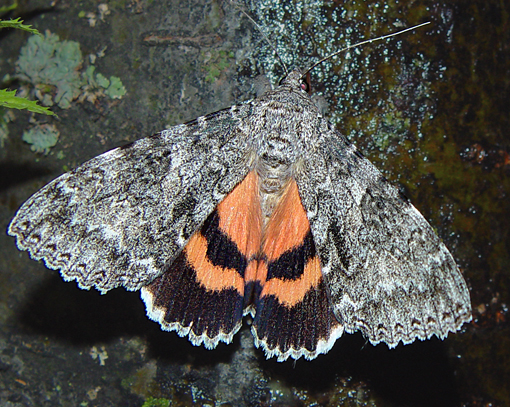

The following checklist for Wisconsin was sent to me by Jeff Crolla. The list was compiled in 2000 (Ferge & Balogh).
I have rearranged the order, grouping by size and hindwing colour.
In most cases the hindwings can be viewed in the individual species files. They are sometimes diagnostic.
Many thanks to Carroll Rudy and Joan F. Rickert who have sent me images and data for Wisconsin counties.
Little Yellow-Orange Underwings: Wingspans: 35-45mm
Little Yellow-Orange Underwings: Wingspans: 35-56mm |

| ** 8876 Catocala micronympha,
the Little Nymph Underwing, (wingspan: 35-50mm). John Himmelman image. |

| ** 8877 connubialis, Connubial Underwing, (wingspan: 35-50mm). The forewing is highly variable and there are several different forms: "sancta" Hulst is the typical form and has forewings with white ground colour and sharply contrasting black lines and markings. There is also brown shading between post medial and subterminal lines; "cordelia" H. Edwards is coloured as above but markings are faint; "pulverulenta" Brower has grey-green forewings with faint markings, sometimes none; "broweri" Muller is the melanic form with forewings that are dark green, almost black. The hindwing has a separate anal spot and the outer band ends with a straight cut. Leroy Simon image. |

| ** 8864 Catocala grynea ; Woody Underwing, wingspan: 40-50mmThe forewing is a dull greenish grey with orangey-brown shading along the inner margin. The antemedial, median and postmedial lines are quite faint.
Praeclara is somewhat similar but has a break in the brown shading
between the am and pm lines. Praeclara also has a paler orange
hindwing color. |

| ** 8865 praeclara; Praeclara Underwing, wingspan: 40-50mmThe forewing is a pale greenish-grey with considerable contrasting brown shading beyond post medial line. There is a black basal dash very close to the inner margin and another dash, higher up in the median area. Note the contrasting shapes of the reniform and subreniform spots. Tim Dyson image. |

| ** 8867 Catocala blandula;
Charming Underwing, wingspan: 40-50mm. |

| Catocala mira;
Wonderful Underwing, wingspan: 40-50mm. |

| ** 8858 Catocala crataegi WO; Hawthorn Underwing, wingspan: 40-50mmDetermination is based on dark (black) shading in forewing basal area continuing along inner margin to anal angle and brown shading beyond postmedial line. There is also a definite greenish cast to median area. The lower wing has the outer black band, broken near the anal angle, distinguishing crataegi from blandula. Tim Dyson image. |

| ** 8841 Catocala abbreviatella; Abbreviated Underwing; wingspan: 40-50mm. The forewing is uniformly colored with narrow black lines on anterior half. The brown reniform spot is ringed with black. The outer black band of hindwing is abbreviated and then continued with a dot. The inner black band also terminates well before the inner margin. Similar species: Catocala nuptialis has solid black reniform spot. C. whitneyi has broad dark triangles in middle of forewing. |

| ** 8842 Catocala nuptialis;
Maried Underwing, wingspan 40-50mm. |
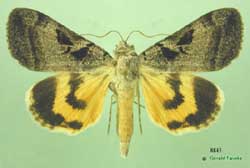
| ** 8843
whitneyi;
Whitney's Underwing, wingspan 45-50mm. |
 |
** 8844 amestris; Three-staff Underwing; wingspan 45-50mm.There is a large pale patch near the apex. In form "westcotti" the hindwing outer black band is complete. In other moths, the band is broken as in abbreviatella. Hindwing ground colour is usually deeper yellow-orange than in similar species. Leroy Simon image. |

| ** 8775 antinympha;
Sweetfern Underwing, wingspan 45-55mm. |

| ** 8772 clintoni; Clinton's Underwing, wingspan 45-55mm.The black basal dash distinguishes clintoni from illecta and abbreviatella, both of which lack the dash. Vernon Brou image. |
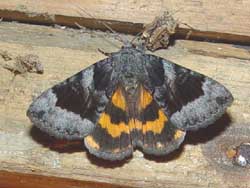
| ** 8776 coelebs; Old Maid Underwing, wingspan 54-56mm.The gray region from the forewing pm line to the outer margin readily distinguishes this species. The fringe is gray on the lower wing from the brief orange dash at the hindwing apex to the anal angle. Tim Dyson image. |
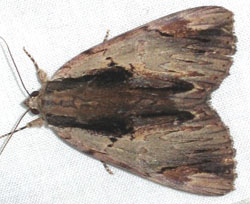
| ** 8857 Catocala ultronia; Ultronia Underwing, wingspan: 50-63mm.The forewings are typically gray-brown, with a distinct and very dark inner margin and a characteristic light brown patch, underscored by a very dark arc, near the wingtip. There can be considerable variation from one specimen to the next. Underwings can be yellow to orange to salmon. |
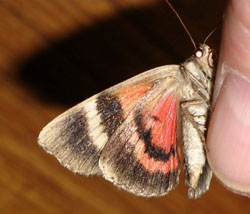
| Catocala ultronia, the Ultronia Underwing, wingspan: 50-63mm.There is extensive orange-salmon colouration on the ventral surface of the hindwings and there is a dark discal lunule.
The ventral surface of the forewings also has a generous suffusion
of orange-salmon scales in the lower half of the median area. |
 |
** 8779 serena Serene UnderwingThe head and collar and abdomen are brown while the thorax is grey. The am and pm lines are thin but very dark and distinct on an otherwise drab, almost uniformly olive-grey forewing. The black marginal band of the lower wings is indented at the center, and the relatively narrow, deep yellow median band parallels this indentation. Basal hairs are brown. Catocala serena courtesy of Carroll Rudy, July 28, Calumet County. |

| #8778 Catocala habilis;
wingspan: 55-65mm |
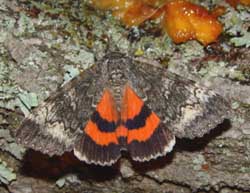
| #8817 briseis;
Briseis Underwing;
wingspan: 60-70mm |

| #8795 Catocala palaeogama
; wingspan: 60-70mm |

| #8795 Catocala palaeogama form phalanga; wingspan: 60-70mm.
In this form, the forewing basal area and subterminal
area are very dark against a much lighter background.
|

| ** 8770 Catocala innubens; Betrothed; wingspan: 55-72mmThe forewing is mottled with white, grey and brown, and the subrenifrom spot tends to be lighter in colour, although it is sometimes obscured by an indistinct blackish bar which runs from the middle of the basal/thorax connection to just below the much lighter apex at the outer margin. Jim Vargo image. |

| ** 8851
Catocala coccinata;
Scarlet; wingspan: 57-70mm |

| ** 8840
Catocala illecta;
Magdalen Underwing, wingspan: 60-70mm |
Solid Black Underwings: Smallest to Largest, Similar Species Paired

| ** 8781
judith,
Judith's Underwing, (wingspan: 45-55mm),
is one of the smaller "black" underwings. |

| ** 8773
Catocala epione ;
Epione Underwing, wingspan: 55-65mm |

| Catocala retecta; wingspan: 60-75mm. Note light coloured, elongated and open subreniform spot which interrupts dark, diffuse ark running through center of wing from basal area (body-wing juncture) to fw apex. Center of reniform spot brown and there is a brown area just below costa running to inner margin just outside pm line. Off-white hindwing fringe only lightly checked along wing veins. Joe Garris image. |

| ** 8784
obscura;
the Obscure Underwing, (wingspan: 60-72mm),
has dull, grey forewings, usually void of any significant dashes or
streaks, providing for easy identification. The antemedial, median
and postmedial lines of obscura are faint and the subterminal line
region is only slightly paler than the rest of the forewing. |

| ** 8794
Catocala lacrymosa;
Tearful Underwing, wingspan: 60-82mm |

| ** 8791
Catocala insolabilis;
Inconsolable, wingspan: 65-75mm
|

| ** 8792
Catocala vidua;
Widow; wingspan: 70-80mm |

| ** 8793
Catocala maestosa;
Sad Underwing, wingspan: 78-98mm |

| ** 8803 Catocala relicta
;
Forsaken, White, Relict; 70-80mm:
Considerable variation with regard to black/white
concentrations on fws. |

| ** 8803 Catocala relicta ; Forsaken, White, Relict; 70-80mm: Considerable variation with regard to black/white concentrations on fws. Form clara: basal and subterminal areas predominantly white.Typical specimens have basal and subterminal areas with blackish scales. Black hws, with brilliant even white inner band and white fringe, are distinctive. June until October. |

| ** 8803 Catocala relicta ; Forsaken, White, Relict; 70-80mm: Considerable variation with regard to black/white concentrations on fws. Form phrynia: evenly dusted with grey over entire forewing. Typical specimens have basal and subterminal areas with blackish scales. Black hws, with brilliant even white inner band and white fringe, are distinctive. June until October, poplars and willows |

| ** 8802 Catocala cerogama BS; Yellow-Banded; wingspan 70-80mm. Several different forms. Pm line distinct, dark with elongate pair of projections. Pm and am lines meet im in relative proximity. Closed subreniform spot lighter than surrounding areas, shaped like an arrowhead with point toward body. Hws distinctive. Jean-Benoît Duval image. BS: Hampshire: October. |

| ** 8802 Catocala cerogama; Yellow-Banded; 70-80mm.Form ruperti: Forewings are almost uniform grey-brown with white scales outlining subterminal line. The hindwings are distinctive. Tim Dyson image. |

| ** 8802 Catocala cerogama; Yellow-Banded; 70-80mm.Form bunkeri: Forewings are dark in median and basal areas. Hw golden band is reduced in thickness. Basal hairs are brown instead of yellow. The hindwings are distinctive. Tim Dyson image. |

| ** 8822
meskei; Meske's Underwing;
wingspan: 65-75mm |
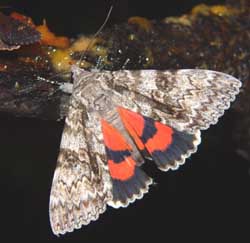
| ** 8821
semirelicta; Semirelict Underwing;
wingspan: 65-75mm |

| ** 8801
Catocala ilia; Ilia;
wingspan: 65-82mm |

| ** 8808 luciana;
Luciana Underwing, wingspan: 70-80mm |

| ** 8771 Catocala piatrix ; Penitent, wingspan: 68-84mmThe forewing has a light-colored band/bar extending from the subreniform spot along the am line to the costa. The fringe of the hindwing is lightly barred and is lighter in color than the deeper orange on the rest of wing. |

| Catocala junctura; Joined Underwing; wingspan: 67-85mm. Forewing is usually dark brownish-gray to evenly powdered blue-grey w/o significant markings. Doubled reniform spot often obscure. Thin, slightly darker am and pm lines run from costa to im and are not widely spaced at im. Hindwing is salmon or orange-pink with narrow inner black band that turns in sharply but does not meet dark-haired im, distinguishing it from unijuga. Gary Anweiler image. |
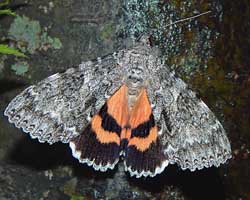
| ** 8805 unijuga; Once-married; wingspan: 70-90mm: Catocala unijuga has a fairly wide black inner band (almost reaching inner margin) in hindwing and very distinctive patterning in forewing. Meskei tend to have narrower band and dustier (less distinct) looking forewing. Semirelicta tend to have inner bands that terminate well before inner margins. Also note the very white fringe on both the forewings and hindwings. Carroll Rudy image. |

| ** 8806 Catocala parta; Mother Underwing, wingspan: 70-85mmThe black dashes in the basal, subapical and anal areas help to identify this species. The hindwings may be yellow to yellowish-orange but more often are salmon-red. Note the face-head-like markings on the thorax. In the hindwing, the first (nearest the apex) black protrusion into the white fringe is "noticeably" larger than the others. |

| ** 8798 Catocala neogama; wingspan 70-85mm. Brown head, thorax, larger size as compared to C. palaeogama. Neogama tend to be slightly smaller than subnata, have darker grey brown fws with more pronounced markings. Examination of hind tibia needed for id. Neogama's: flattened, unevenly, sparsely spined; subnata's: cylindrical, spines dense, uniform in distribution. Joe Garris photo. |

| ** 8797 Catocala subnata;
Youthful Underwing, wingspan: 75-90mm.
Forewings are greyish white with blue-grey and light brown scales.
Catocala subnata usually have hindwings brighter
yellow than those of neogama. Neogama usually
have basal dash; absent in male subnata, but present in females. |

| ** 8796 Catocala nebulosa;
Clouded; wingspan 75-86mm |

| ** 8833 concumbens Sleepy Underwing or Pink Underwing (wingspan: 60-75mm).This brown thoracic collar is quite evident in this image as is the interruption in the pm line by the open subreniform spot. The white hindwing fringe is only lightly checked on the wing veins. The vibrant pink bans are distinct in colour and also in their relatively smooth contour. |

| ** 8832 Catocala cara;
Darling; wingspan 70-85mm |

|
** 8834 amatrix Sweetheart Underwing; (wingspan 75-95mm)This species is very skittish and frequently hides in caves, under bridges, under tree bark, etc. by day, resting with head down. The hindwing patterning and colouration are similar to that of Catocala concumbens, but the large size (wingspan 75-95mm) and the dark bar running from the basal area to just below the apex distinguishes Catocala amatrix. See large Catocala amatrix courtesy of Joan F. Rickert, Aug 30, Taylor County. |

Catocala unijuga, courtesy of Joan F. Rickert, Taylor County,
Wisconsin,
September 03, 2006, id by Bill Oehlke.
Catocala serena July 28, 2006
Catocala unijuga August 26, 2006
Catocala clintoni July 9 2007
Catocala myra July 23, 2007
Catocala grynea July 23, 2007
Catocala ultronia July 23, 2007
Taylor County sightings by Joan F. Rickert:
Catocala amatrix August 30
Catocala unijuga September 3